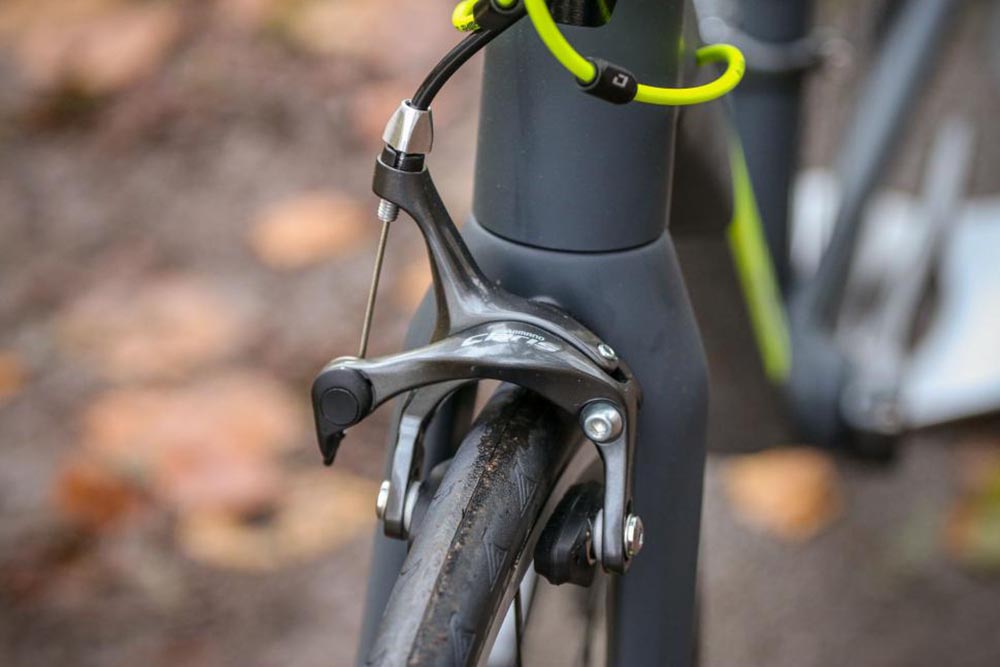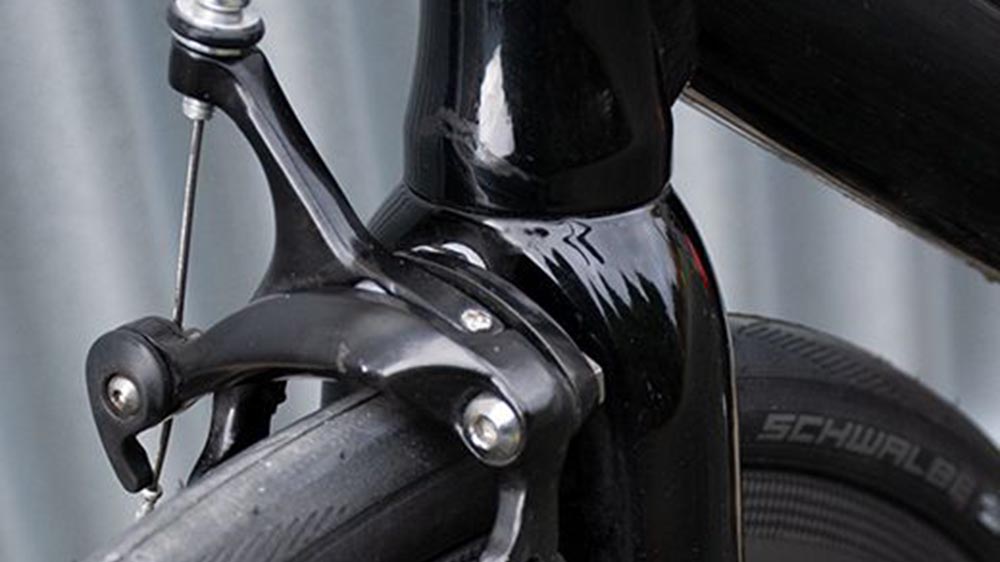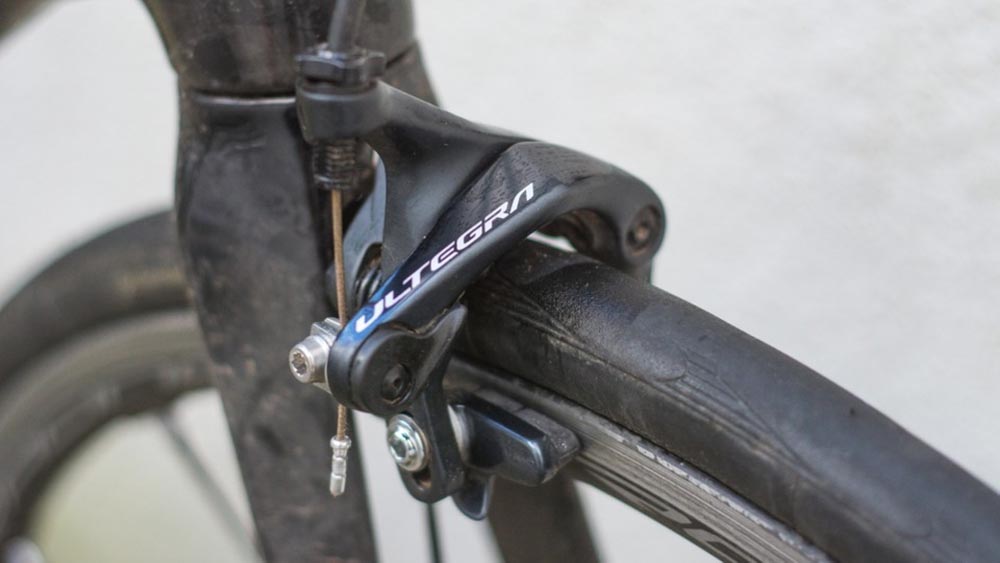Rim Brakes: List of Pros and Cons

When it comes to bike brakes, you have two styles to choose from. This guide outlines the pros and cons of rim brakes to help you decide on your next bike choice. I’ll also outline the different types of disc brakes and rim brakes that are available.
Advantages of rim brakes
Rim brakes are easier to service and maintain – Rim brakes are simple. If something goes wrong, you can rip the entire brake apart on the side of the road with just one multi-tool. It’s also easier to diagnose rim brake problems. Because they are completely open, you can easily see if there is a problem. Rim brakes are also much less common than disc brakes. If they are not perfectly adjusted, they will still work fine. You don’t have to know how to bleed hydraulic brakes.
Rim brake parts and spares are easy to find anywhere in the world – rim brakes have been the standard bike brake for decades. If you’re riding in a developing country, you can easily find calipers, cables or brake pads no matter where you ride. You can find spare parts in every corner of the world, including the smallest country bike shop. If you’re touring in developed countries, you can find replacement pads and cables at most department stores. This is especially important for cyclists who often find themselves finding spare parts in rural or remote areas where it can be a challenge.
Rim brakes are cheaper – if you’re on a tight budget, rim brakes are a good option. Parts and spares cost less because they are simpler and more common. You also don’t need rotors as the rim provides the stopping surface. On average, I would guess that rim brake assemblies cost 10-20% less than comparable disc brake assemblies. Used parts are also readily available. If you need calipers, you can buy used calipers for a few dollars at most bike shops. Cushions are also cheap.
Rim brakes are easier on the wheel – because the brakes apply the braking force directly to the rim, there is a lot less stress on the spokes. Your wheels stay true longer. You’ll break fewer spokes. For this reason, rim brakes are a better choice if you’re using low-end wheels. Of course, no matter what brakes you choose, well-built wheels will stay true.
Rim brakes are easier on the fork legs – because the rim brakes are mounted on the fork close to the stem, less force is applied to the fork legs. This allows for a more flexible fork that provides better shock absorption and comfort. Your fork will last longer without cracking or failing.
High-quality rim brakes perform just as well as low-end disc brakes – if you’re planning to buy a new bike with disc brakes or upgrade your current bike for better braking performance, make sure you’re actually upgrading. Modern rim brakes are very good. Cheap mechanical disc brakes aren’t that great. In some cases, it may be better to stick with what you have.
Rim brakes don’t rub – because the pads are farther from the braking surface, they don’t rub unless it’s not properly adjusted or the wheel isn’t right. If they start to rub, it’s easy to make minor adjustments to fix the problem.
Rim brakes are lighter – If you strive to make your bike as light as possible, using rim brakes can save you about 1 pound (450 grams). Without discs, the calipers are smaller, saving weight.
Rim brakes are more aerodynamic – on flat and downhill sections you get a slight advantage because you don’t have the drag of the calipers and rotors sticking out. The faster you ride, the more important your aerodynamics are.
Rim brakes are safer – some pro racers have complained of being cut by the brake discs in accidents. This has nothing to do with rim brakes.

Rim brakes are a classic – you probably grew up riding a bike with rim brakes. They have been the standard for decades.
Front rim brake on blue bike
Disadvantages of rim brakes
Rim brakes don’t stop as well as disc brakes – rim brakes don’t give you as much mechanical advantage as disc brakes. They have less influence. We know this because rim brake pads have to travel farther than disc brake pads for the same lever pull. The rim brakes have to move a centimeter or so to make contact with the rim. The disc pad only needs to move a few millimeters. This means that the calipers can’t apply too much force to the braking surface to slow down the bike. Rim brake pads also have less surface area to contact the braking surface. This means they create less friction. When you use rim brakes, your stopping distance will be slightly longer.
The rims don’t last long—every time you brake with the rim brake, you rub off some of the rim material. Over the course of thousands of miles of riding, your rims will eventually wear out. The friction from the rim brake rubbing against the rim also heats up the rim. The cycle of heating the rims by braking and letting them cool again can also weaken the rims over time. The difference isn’t huge, but other things being equal, when you’re using rim brakes, you’ll probably have thousands of miles off your rim.
Rim brakes don’t work well in wet weather – when the rims and pads get wet, they become slippery. Water reduces friction. This reduces the braking force of the brakes. Sometimes it takes your wheels a full turn before the brakes start to slow you down. In this revolution, the pads suck water from the rims. This makes the braking force inconsistent.
Heat build-up is a problem with rim brakes—friction can cause the rim to heat up during long, steep descents. Many problems can arise from this. Most commonly, heat causes the air pressure in the tire to increase. Usually, the tire will blow off the rim. This is called a blowout. If this happens, you need at least a new tube and maybe a new tire. Worst case, the rim bursts and you need a new wheel. To fix this, sometimes you have to stop during the descent to let the rim cool before continuing the descent.
If your wheel bends or deviates too far from true, you won’t be able to ride – the pads will rub against the rim, making it impossible to ride. This happened to my friend last year. He leaked oil and bent the rims badly. His wheel barely spins after that because it’s rubbing against the brake arm. With disc brakes, this shouldn’t be a problem since the rotor is the stopping surface, not the wheel.
Rim brakes are more dangerous – Rim brakes generally have longer stopping distances than disc brakes. If you need to stop quickly in an emergency, you may not be able to stop quickly enough.
You can’t easily run multiple wheel sizes – some riders have a bike and they swap out the wheels for a different purpose. For example, maybe they have a 700c wheelset for road riding and a 650b wheelset for mountain biking. You can’t do this with rim brakes because the rims are in a different position relative to the frame. If you want to ride a different size wheel, you’ll need another bike. Regardless of the size of the wheel, the disc is always in the same position.
You must clean your rims and pads frequently – sand, mud or other debris gets stuck on the rims and pads. When you hit the brakes, it scratches your rims. If you don’t remove the debris, it will eventually damage your rims. I had a hard time learning this after riding at the beach and didn’t clean my rims right away.

Rim brakes aren’t as precise — you can’t control exactly how much brake you apply. Your wheels are more likely to lock up. This makes riding on difficult terrain more challenging as you are more likely to lose traction.
Using the rim brakes wasn’t quite as satisfying – it could be a personal preference or it could have something to do with the quality of the brakes I’m using, but the rim brakes didn’t feel as firm when I grabbed the brake levers.
Rim brake pads don’t last long – Rim brake pads use softer materials to increase rim life. Because the pads are made of softer materials, they wear out faster.
Rim brakes limit your maximum tire width – the rim brake arms must reach around your tire so they can grip the rim. Some rim brake calipers are too narrow to accommodate wide tires. The tires will rub against the brake arms, or simply not fit between the pads. Disc brakes do not limit tire width. Your frame and rims are the only limiting factors.
Rim brake technology is less advanced – After the recent move from rim brakes to disc brakes in professional bikes, there is more research and development in disc brake technology than ever before. The automotive industry has been using disc brakes for many years. Some of these technologies can also be applied to bicycles. The result is incredibly smooth, consistent and reliable braking technology.
Rim brakes are obsolete – the bike industry is moving away from rim brakes. If you’re in the market for a new bike that you plan to ride for years, you may want to use disc brakes to help make your bike more futuristic. Who knows, maybe new rim brakes will be hard to find in the next 20 years. maybe not.
If you are looking for a new way of commuting or want a healthier lifestyle, we are here to help you. Visit our website to learn more about electric bikes and electric scooter or please leave information to us.
 Shuangye ebike
Shuangye ebike
